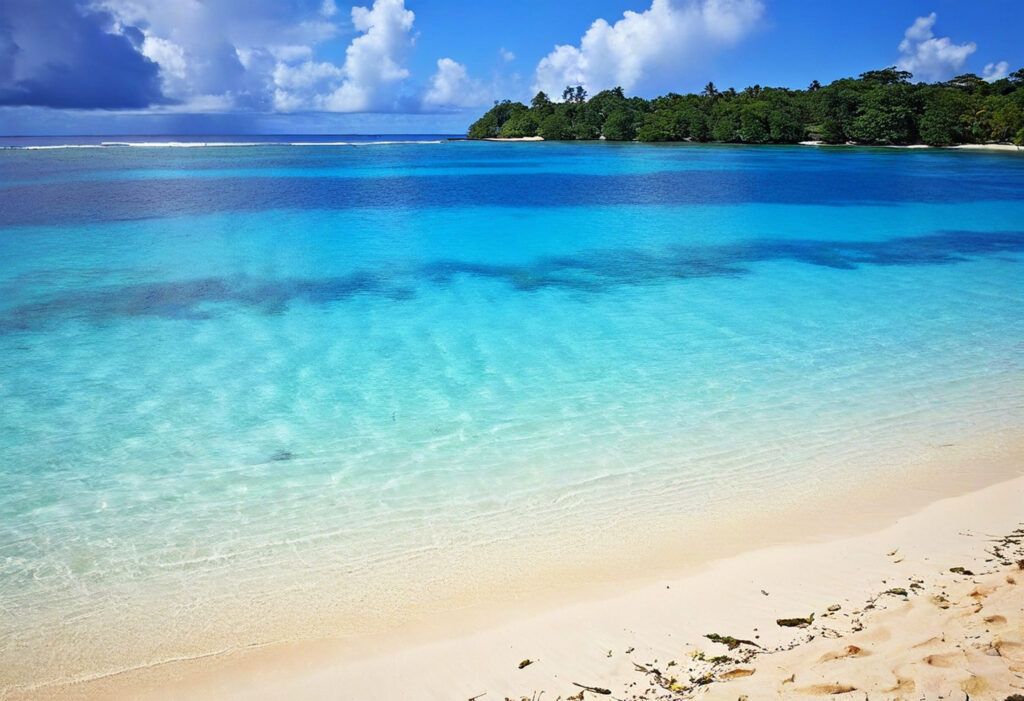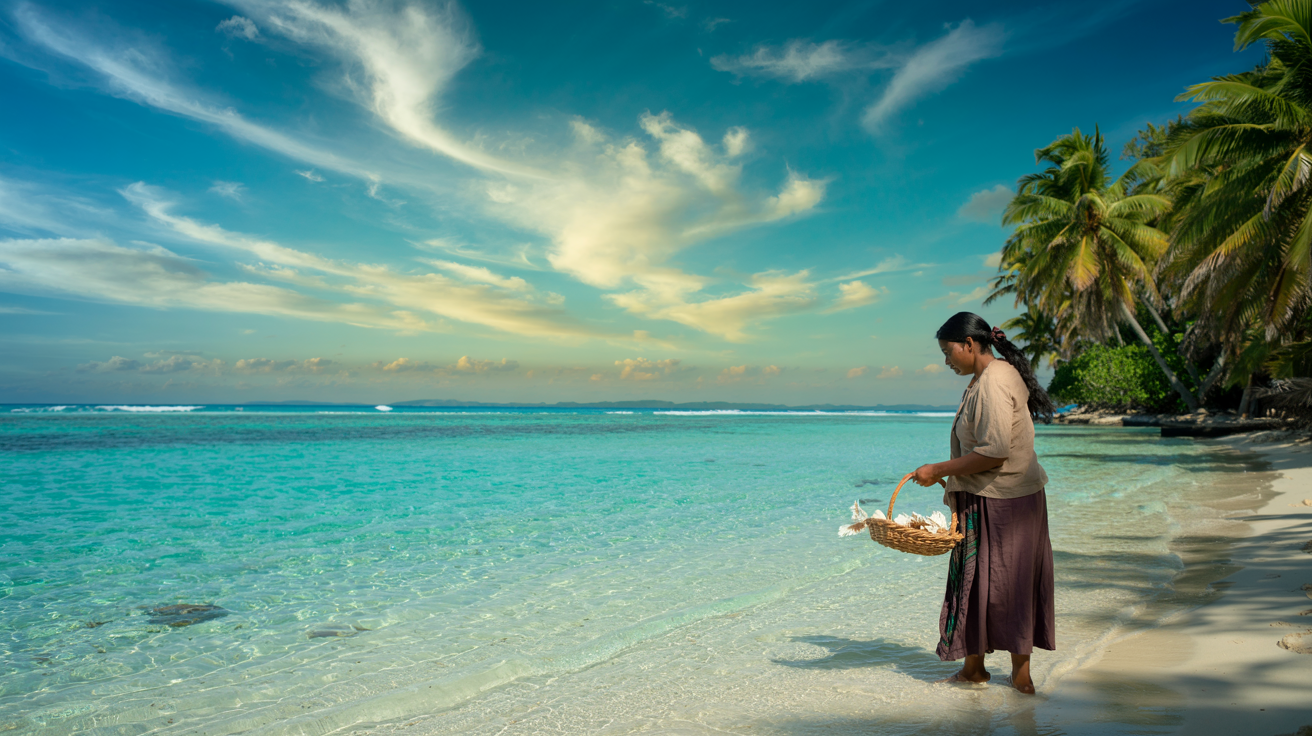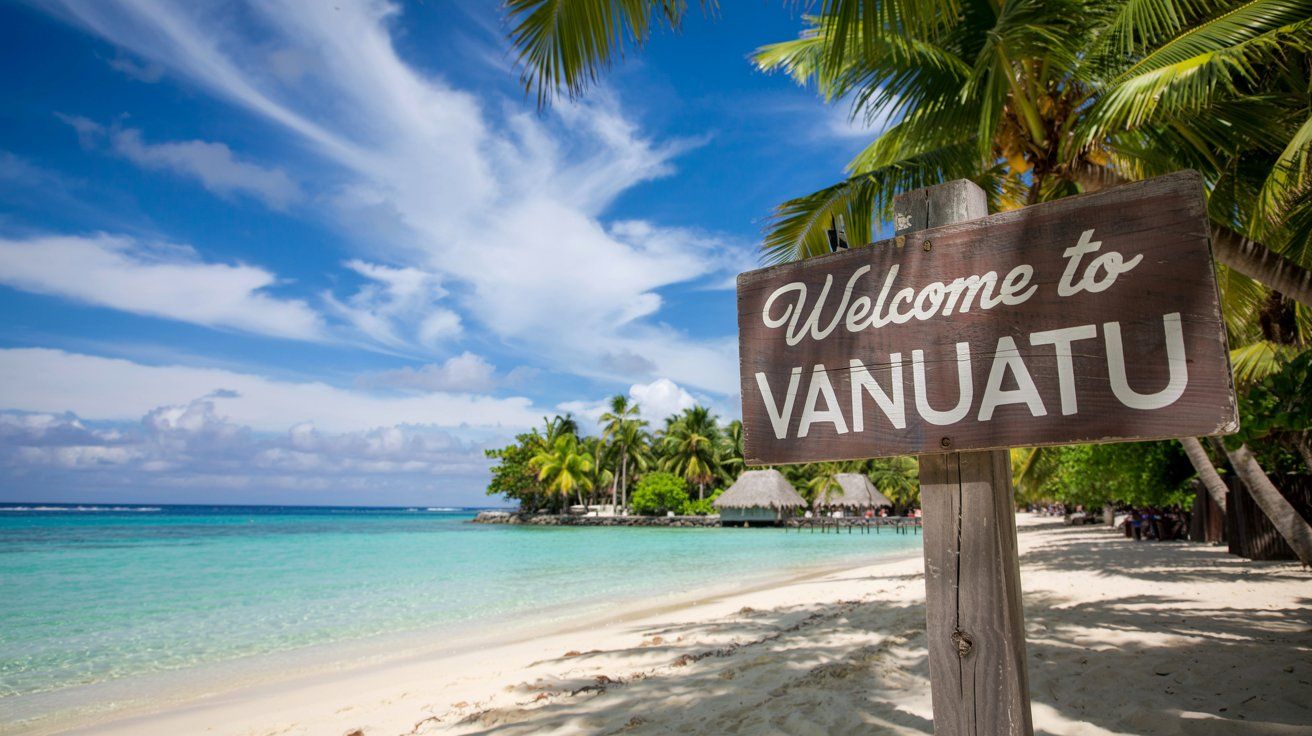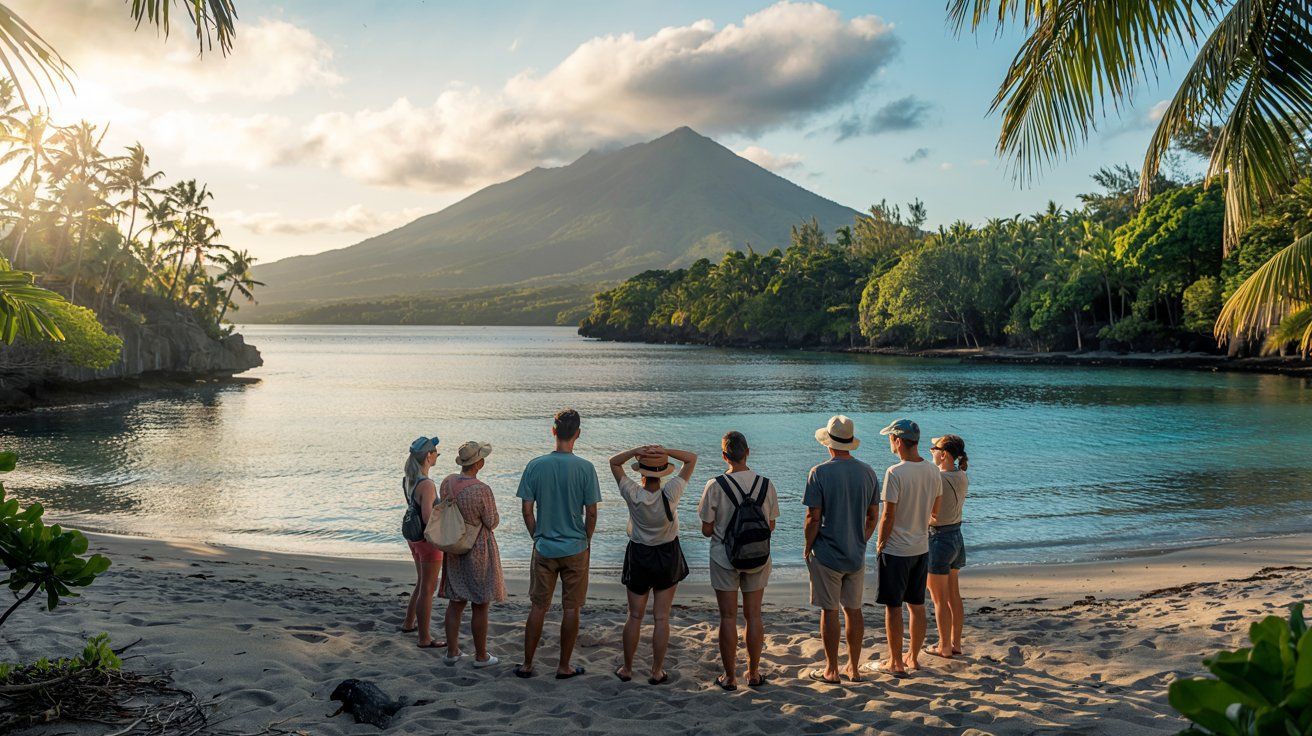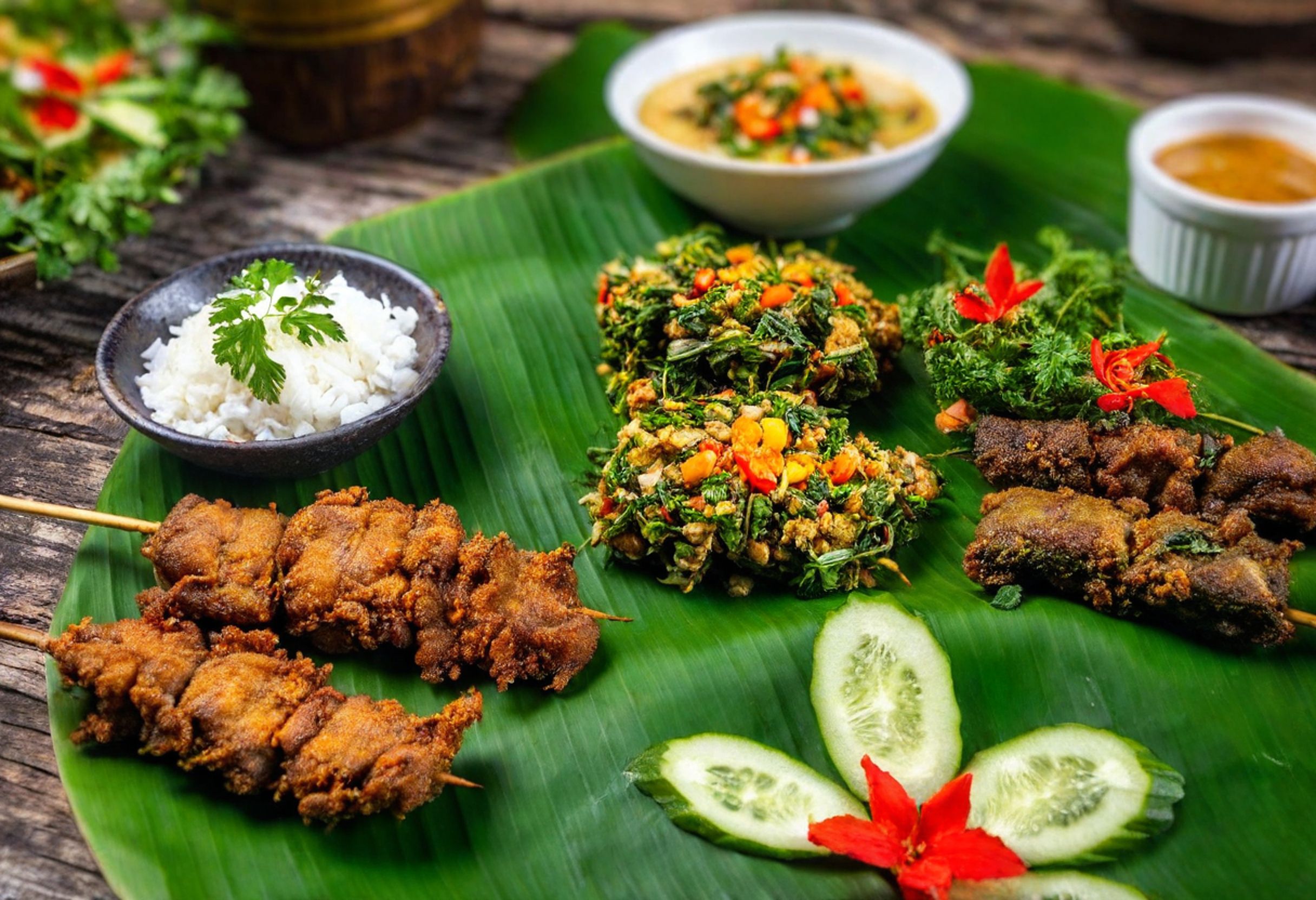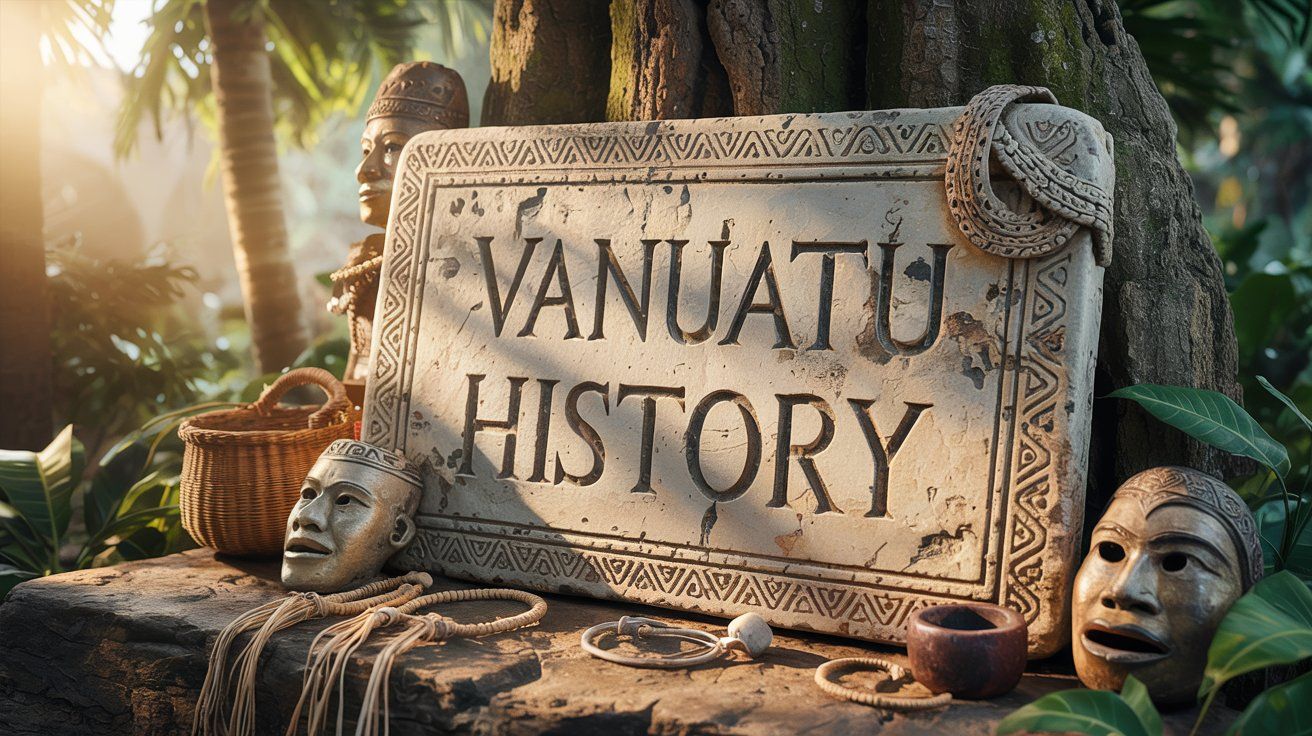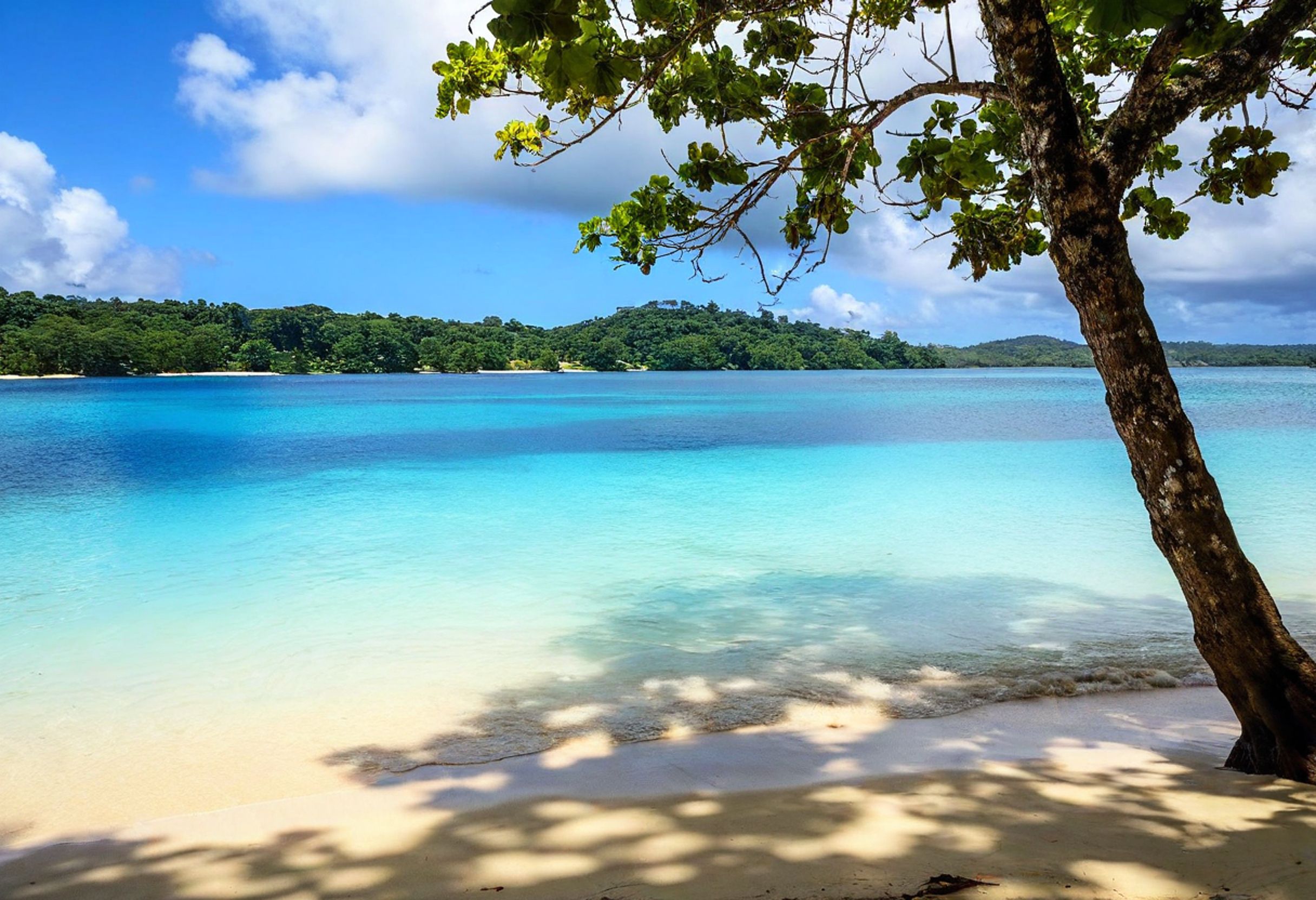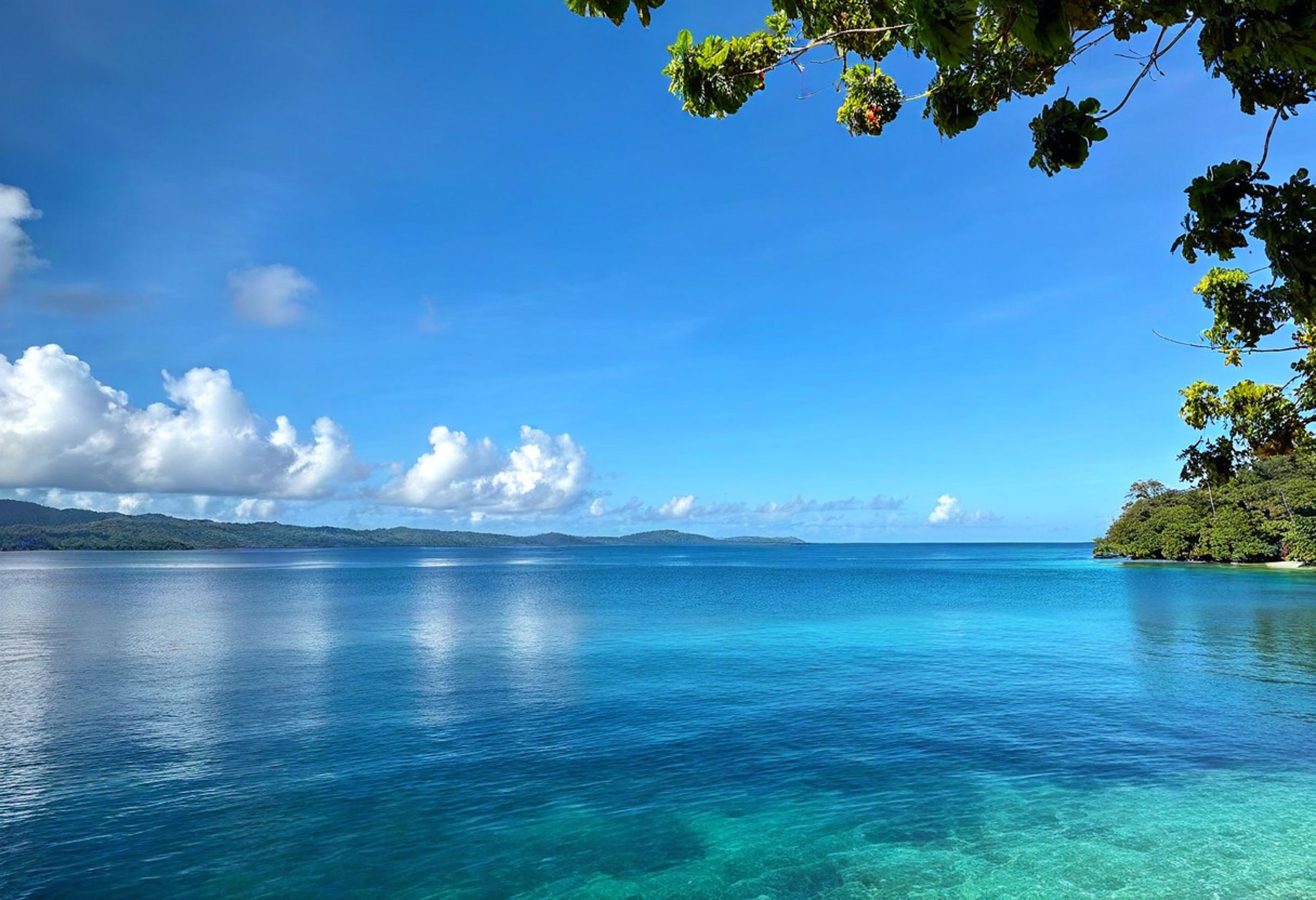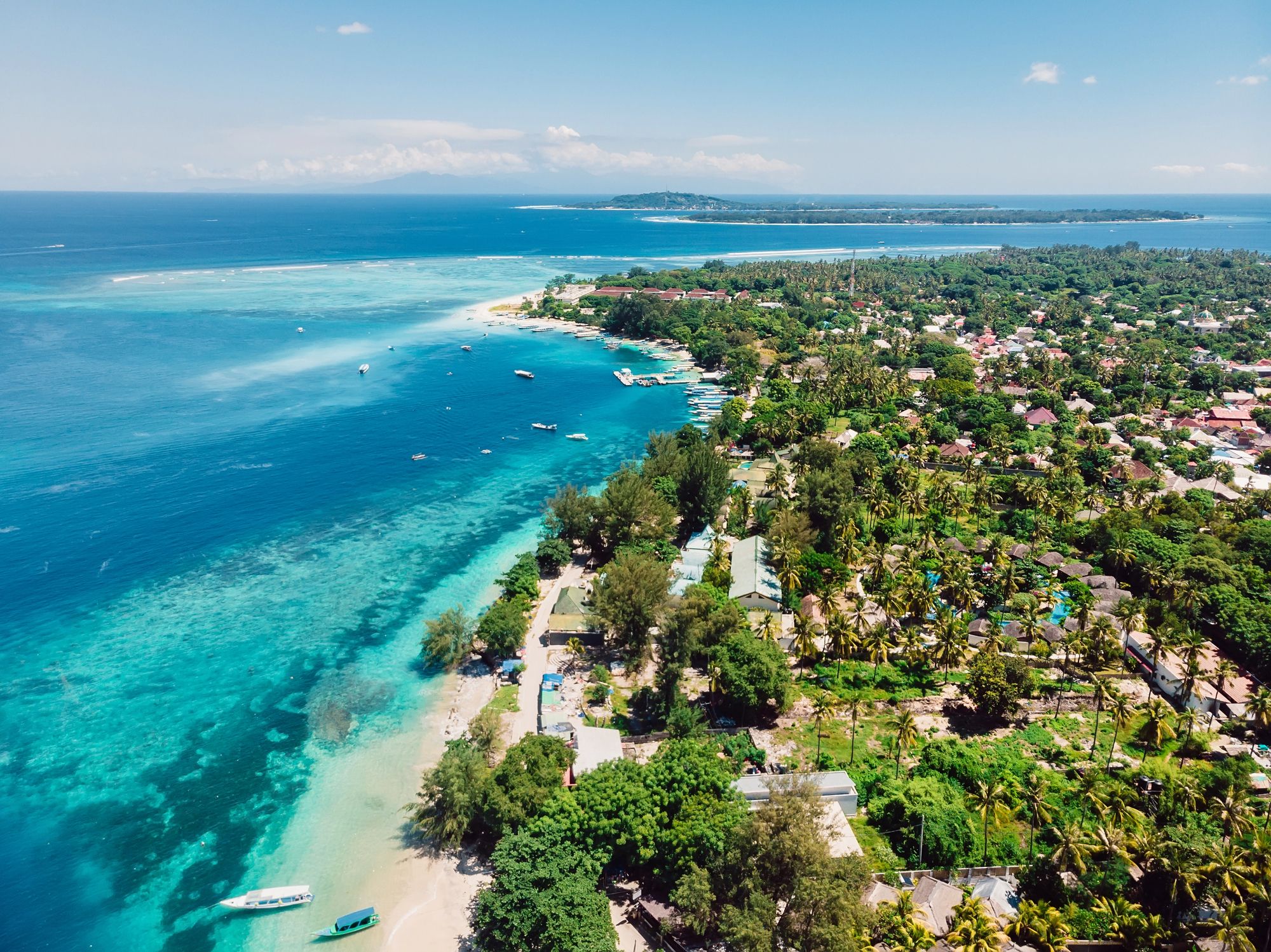Tucked away in the heart of the South Pacific, Penama Province stands out as one of Vanuatu’s lesser-known gems. The region is made up of three main islands: Pentecost, Ambae, and Maewo. Each one brings its own flavor—think wild landscapes, distinct traditions, and a vibe you just won’t find anywhere else.
Penama Province gives adventurous travelers the chance to discover breathtaking waterfalls, volcanic terrain, and real cultural encounters far from the usual tourist routes. Here, you might find yourself trekking through thick forests, scaling green mountains, or watching colorful birds flit around. The roughly 31,000 people who call Penama home tend to greet visitors with an openness and friendliness that’s honestly hard to beat.
From overwater bungalows to beachfront resorts, find your perfect stay in this island nation of more than 80 islands. Instant booking with best price guarantee!
Browse Accommodations Now
When it comes to places to stay, you’ll find everything from simple guesthouses to traditional bungalows. Sure, the facilities aren’t as fancy as Port Vila’s, but the authentic experience and stunning nature more than make up for it. The land diving ritual on Pentecost Island is probably the most famous thing here, but honestly, every island has its own surprises.
Overview of Penama Province
Penama Province blends natural beauty with deep cultural traditions across its three islands. This part of Vanuatu sits a bit off the beaten path and gives visitors a chance to experience the country without the crowds.
Geography and Location
Penama Province sits in Vanuatu’s central-eastern archipelago, right in the South Pacific. The name “Penama” comes from the first two letters of Pentecost, Ambae, and Maewo.
Volcanic activity has shaped the landscape here. Ambae Island, for example, has Manaro Voui, one of Vanuatu’s active volcanoes. Sometimes, the volcano acts up and people have to evacuate.
The terrain jumps from flat coastal stretches to steep, jungle-covered mountains. Maewo is especially famous for its waterfalls—locals call it the island of many rivers. The whole province has a tropical climate, with clear wet and dry seasons.
Key Islands of Penama
Pentecost Island made a name for itself with the land diving ceremony (nagol), an ancient ritual that inspired bungee jumping. During yam harvest season, men jump from tall wooden towers with only vines tied to their ankles. It’s wild to watch.
Ambae Island is home to Lake Voui, a crater lake at the top of Manaro volcano. The island even inspired James Michener’s “Bali Hai” in “Tales of the South Pacific.”
Maewo Island boasts some of the country’s most beautiful waterfalls and rivers. The scenery is lush and dramatic, but don’t expect fancy hotels—tourism is low-key, and that’s kind of the point.
Population and Local People
About 31,000 people live in Penama Province. Most are indigenous Ni-Vanuatu who stick to small villages and follow traditional customs.
People usually speak their own local languages first, then Bislama (Vanuatu’s creole). English and French are official, but you don’t hear them much outside the main towns.
Villagers mainly farm, fish, and make crafts. Yams are a big deal, especially on Pentecost Island, where they tie into spiritual beliefs and the land diving tradition.
If you visit, bring a small gift and always ask before taking photos—it’s just good manners, and locals really appreciate the respect.
How to Get to Penama
Getting to Penama Province takes a bit of planning, but the journey is part of the adventure. The province is made up of Ambae, Pentecost, and Maewo.
By Air and Sea
Air Vanuatu runs domestic flights from Port Vila’s Bauerfield International Airport to Penama. Planes usually land at Longana Airport on Ambae and Lonorore Airport on Pentecost. Flights go a few times a week, but weather and demand can change things up.
If you’re traveling on a budget, ferries are a solid option. Boats connect Santo (Espiritu Santo) to Ambae, with the trip taking three to four hours depending on the sea. It’ll cost about 2,000 vatu (roughly $20 USD) to west Ambae, or 2,500 vatu to north Ambae from Santo.
Boats often stop at different villages along the way, which adds time but gives you a peek at local life.
Visa and Entry Requirements
Most travelers can grab a 30-day tourist visa when they arrive at Vanuatu’s international airports. Just make sure your passport is good for at least six months past your planned departure.
Keep your passport and visa handy when moving between provinces—sometimes local officials want to check them. You don’t need any extra permits to visit Penama specifically.
Rules can change, so it’s smart to check with Vanuatu’s Department of Immigration before you go. The country code is +678, which comes in handy if you need to call ahead.
The Penama Tourism Information Center, run by Mr. William Mala, keeps up-to-date info on local transport and places to stay. Honestly, reaching out before you go is a good idea.
Top Islands and Destinations
Penama Province’s three islands each offer something different. From active volcanoes to waterfalls and traditions that go back centuries, there’s plenty to explore.
Ambae Island Highlights
Manaro Voui, the active volcano, towers over Ambae Island and sets the stage for some pretty stunning scenery. The black sand beaches and thick forests make for great hiking. Head to the eastern villages for the best views of the crater lake—when the clouds clear, it’s unforgettable.
Coastal communities here are small and friendly, offering a real taste of village life. Fresh fruit and seafood are everywhere.
If you love the ocean, don’t skip the underwater spots. The black sand beaches lead straight into coral reefs that are perfect for snorkeling.
Pentecost Island Attractions
Pentecost is best known for the land diving (Nagol) ritual, which happens from April to June. Men leap from towers with vines tied to their ankles—it’s the original bungee jump and a wild thing to witness.
Inside the island, you’ll find rugged hills, valleys, and hiking trails that link up traditional villages. The western coast has some of the friendliest communities.
Pentecost doesn’t get overrun with tourists, so you get a more genuine experience. You can even stay in traditional bamboo huts.
Local markets sell handmade crafts and fresh produce. The coastline has tiny coves and beaches—ideal for relaxing after a day of exploring.
Maewo Island Adventures
Maewo Island is all about water. Waterfalls tumble down the eastern side, and the tallest ones take a bit of hiking through thick rainforest to reach—but it’s worth every step.
If you’re into wildlife, keep an eye out for giant coconut crabs at night. They’re protected, so look but don’t touch.
The west coast has black sand beaches and crystal-clear water for swimming and snorkeling. Villages along the shore offer homestays if you want to really experience local life.
Maewo also has some cool cave systems. Local guides can take you through limestone caves and share stories about how people used them for shelter during cyclones.
Natural Wonders and Outdoor Activities
Penama Province is a dream for outdoor lovers—think waterfalls, volcanoes, and dense rainforest across Pentecost, Ambae, and Maewo. The volcanic history here means the landscape is always changing and full of surprises.
Trekking and Hiking
The mountains in Penama make for some great hikes. On Maewo, you can walk to waterfalls through thick rainforest. Trails often pass through traditional villages, and locals might offer to guide you for a small fee.
Ambae has tougher hikes up to high points with sweeping ocean views. The best time to hike is between May and October—less rain, better trails.
Bring sturdy shoes, water, and bug spray. Some paths get muddy in the wet season, so always check with locals before heading out.
Villages usually ask for permission before you cross their land. Hiring a local guide not only shows respect but also adds a lot to your experience.
Snorkeling and Diving
The waters around Penama are packed with coral reefs and sea life. Moon Cave near Asanvari on Maewo is a favorite snorkeling spot, with underwater caves full of colorful fish.
The ocean is warm and clear most of the year, but the dry season is the best for visibility.
Most guesthouses can set up boat trips to good snorkeling spots. Gear rentals are rare, so if you’ve got your own, bring it.
Some dive sites have dramatic drop-offs, coral gardens, and you might even spot turtles or reef sharks. Pentecost doesn’t have much dive infrastructure yet, but that means the sites are untouched and perfect for adventurous divers.
Elegant resorts, tropical villas, and vacation rentals with immediate confirmation. Experience a culture dating back to 1,300 BC in this breathtaking archipelago!
See Available Properties
Volcano Exploration
Volcanoes are a huge part of life in Penama. Manaro volcano on Ambae dominates the island, with three crater lakes at the top.
Guides can lead you up to see the lakes, including Lake Voui, which sometimes changes color thanks to volcanic activity.
Safety is super important here. Always check the current volcano alert level and go with guides who know what to look out for.
The volcanic soil makes the whole province incredibly fertile. As you explore, you’ll notice just how much the local farms thrive.
Fishing and Marine Life
Fishing is part of daily life, and you can join locals to try traditional methods. Many guesthouses can arrange fishing trips, where you might catch tuna, mahi-mahi, or reef fish.
Spearfishing is a big deal here—if you’re curious, locals will often show off their impressive free-diving skills.
The seas are full of reef fish, octopus, and sometimes dolphins pass by.
Some villages use traditional conservation methods, like temporary no-fishing zones, to keep fish stocks healthy.
For the best fishing, ask locals about the seasons and the most respectful ways to fish. Early morning and late afternoon are usually the best times to avoid the hottest part of the day.
Culture and Heritage
Penama Province is a patchwork of cultures and traditions spread across three islands. The Ni-Vanuatu people here stick close to their roots, even as modern life creeps in.
Languages and Traditions
Each island in Penama has its own mix of languages and dialects. On Pentecost alone, you’ll hear at least five different languages. Ambae and Maewo each have their own, too. Most folks also speak Bislama, and you’ll get by with basic English in tourist spots.
The land diving (Nagol) on Pentecost is the most famous tradition. It happens between April and June. Men jump from wooden towers with vines tied to their ankles—a wild test of bravery and a way to bless the yam harvest.
Big Nambas and Small Nambas villages keep old customs alive. The names come from the size of the penis sheaths men wear. If you visit, go with respect and you’ll get a real taste of traditional life.
Festivals and Events
Every year, Penama celebrates big cultural milestones. The land diving season on Pentecost draws people from all over to see this centuries-old ritual.
Harvest festivals are a big deal, especially for yams, which are central to the culture. Expect traditional dances, bamboo music, and huge feasts.
Archaeological sites—especially on Maewo—show that people have lived here for thousands of years. Some places are open to visitors and give a glimpse into ancient Melanesian life.
Tourism brings both good and bad. It helps the economy but can put pressure on traditions. Most villages welcome respectful visitors and may ask for a small fee that goes back into the community.
History of Penama and Vanuatu
Penama Province and the rest of Vanuatu have a rich and tangled history, stretching back thousands of years. From the first settlers to the colonial era and then independence, the story is full of twists and turns.
Early Settlement and Archaeology
Archaeologists have found evidence that people settled in what we now call Vanuatu at least 4,000 years ago, with the oldest discoveries dating back to around 2000 BC. Those early voyagers were skilled navigators, crossing huge stretches of ocean in canoes.
People have lived on the islands of Penama Province—Pentecost, Ambae, and Maewo—for countless generations. Over time, these close neighbors built strong trading ties. You can still spot the results of this long exchange in their crafts, traditions, and oral histories.
Local kastom (custom) stories tie people closely to their surroundings. These tales, passed down by word of mouth, keep knowledge alive about the land, the sea, and how people connect with each other.
European Contact and Colonial Era
Europeans first set foot in Vanuatu in 1606 when Portuguese explorer Pedro Fernández de Quirós landed and named the islands “Australia del Espiritu Santo.” He thought he’d finally found the legendary southern continent.
Captain James Cook showed up in 1774, mapped the islands, and called them the “New Hebrides.” That name stuck for nearly 200 years.
By the late 1800s, European traders, missionaries, and planters had moved in, triggering major cultural shifts and sometimes outright conflict.
In 1906, Britain and France set up a pretty odd joint colonial government—the Anglo-French Condominium. The result? Two sets of everything: laws, money, police, even schools. You can imagine the confusion and frustration this caused for locals.
Path to Independence
After World War II, decolonization movements picked up steam around the globe, and Vanuatu was no exception. By the 1960s, local leaders started demanding self-rule.
The first political parties popped up in the early 1970s. The Vanua’aku Pati, led by Father Walter Lini, became the main voice for independence and unity.
Nationalist energy kept building, leading to protests and tough negotiations with the colonial authorities. French settlers and some local groups tried to push back, but the independence movement just kept growing.
On July 30, 1980, the New Hebrides officially became the independent Republic of Vanuatu. The new name, “Vanuatu,” means “Our Land Forever” in several local languages—a pretty clear sign of pride and hope for the future.
World War II and Beyond
World War II turned Vanuatu into a vital Allied base in the Pacific. American troops built large military facilities, especially on Efate Island.
Thousands of ni-Vanuatu (Vanuatu citizens) worked with the military, picking up new skills and ideas along the way. The sudden arrival of so many Americans and all their gear changed island life in all kinds of ways.
After independence, Vanuatu joined the Non-Aligned Movement to show its commitment to neutrality during the Cold War. The country set up a parliamentary democracy but also kept many traditional governance systems alive.
Penama Province has held onto its traditional lifestyle, even as it adapts to the modern world. If you visit today, you’ll find villages where ancient customs and modern life exist side by side—a fascinating blend of old and new.
Practical Information for Travelers
If you’re thinking about visiting Penama Province, it helps to know a few practical things about the weather, money, and how to stay connected.
When to Visit and Weather
Penama has a tropical climate with two main seasons. The dry season, from May to October, is cooler and less rainy—most people prefer to visit then, especially if you’re planning to hike or climb.
The wet season (November to April) brings higher humidity, frequent rain, and the occasional cyclone. The scenery gets lush and the waterfalls are spectacular, but some activities might get rained out.
Temperatures usually hover between 24-29°C (75-84°F) all year. The mountains can make things cooler at higher altitudes, so you might want to pack a light jacket for evenings during the dry season.
Bring lightweight, breathable clothes no matter when you visit.
Currency and Costs
You’ll need Vanuatu Vatu (VUV) in Penama. There aren’t any ATMs in the province, so grab enough cash in Port Vila or Luganville before you leave.
Most places to stay are:
- Guesthouses: 3,000-5,000 VUV per night
- Homestays: 2,000-4,000 VUV per night
- A few tourist resorts: 8,000-15,000 VUV per night
Meals usually cost 1,000-3,000 VUV, depending on where you eat. Local markets have fresh produce for less than prepared meals.
Credit cards? Pretty much useless here. Cash is king, and small bills are handy for rural areas.
Electricity and Communication
Vanuatu runs on 220-240 volts with Australian/New Zealand-style plugs (Type I). In Penama, power is spotty at best. Most settlements use generators, usually only in the evenings.
Easy booking across stunning accommodations from luxury resorts to eco-friendly retreats. This Y-shaped archipelago offers pristine beaches, active volcanoes, and world-class diving!
Secure Your South Pacific Getaway
A lot of places rely on solar power, so you won’t always get to charge your devices. Bring a portable power bank and maybe even a solar charger if you’re staying a while.
Some tips for electricity:
- Pack a universal adapter with surge protection
- Charge devices whenever you get the chance
Mobile coverage works in main villages with Digicel and Vodafone, but it’s unreliable in remote spots. WiFi is rare, slow, and pricey.
Buy a local SIM card in Port Vila before you head to Penama for the best shot at staying connected.
Where to Stay in Penama
Staying in Penama gives you a real taste of Vanuatu life. Options run from village guesthouses to eco-friendly properties. Most places are pretty basic, but you’ll get a warm welcome and stunning views.
Village Guesthouses
Penama’s family-run guesthouses offer a close-up look at local life. On Maewo, Mule Ocean View Guest House has simple rooms and gorgeous ocean views. Samuel Guesthouse and Kerempei Guest House in north Maewo can sleep up to 7 people in 4 rooms.
Walarua Guesthouse is about a 15-minute walk from Sara airfield. If you need more space, Ezekiel’s Guesthouse has three bedrooms (each with two single beds) and a kitchen.
Most guesthouses include:
- Shared bathrooms
- Simple beds
- Home-cooked meals
- Cultural activities
Prices usually run 2,000-4,000 vatu per night ($17-35 USD). It’s a good idea to book ahead, since communication can be tricky.
Eco Lodges and Resorts
Penama has a handful of eco-friendly places to stay that blend comfort with sustainability. These lodges use solar power, collect rainwater, and build with local materials.
You’ll find a mix of traditional style and modern touches—think proper beds and private bathrooms, but in buildings that fit the landscape. Many sit right by the beach or tucked in the jungle.
What makes these places stand out:
- Cultural activities: Dance, cooking classes
- Adventure: Guided hikes, waterfall trips
- Environmental education: Learn about conservation efforts
- Sustainable practices: Many support community projects
Meals feature local produce, fresh seafood, and traditional recipes. Expect to pay 6,000-12,000 vatu per night ($50-100 USD), depending on where you stay.
Food, Drink, and Local Cuisine
Penama Province lets you dive into authentic Ni-Vanuatu flavors, with fresh local ingredients and traditions you can taste in every bite. The food scene sticks close to island roots, but you’ll spot the occasional international influence.
Traditional Dishes
If you try one thing, make it Lap Lap—Vanuatu’s national dish. Locals grate yam or taro, wrap it in banana leaves, and slow-cook it with coconut cream in underground ovens.
Coconut Crab is a real treat here. These giant land crabs feast on coconuts, which gives their meat a sweet, distinctive flavor. People usually steam them or cook them in coconut milk to let the taste shine.
Seafood is everywhere, with fish caught daily by local fishermen. If you’re lucky, you might find lobster on the menu too.
Fruits like mango, papaya, pineapple, and banana are everywhere. You’ll get them fresh at meals or in simple desserts.
Dining Experiences
Eating by the beach is a classic Penama experience—stunning views, fresh air, and local food. Small family-run restaurants serve up Ni-Vanuatu specialties, often with a killer backdrop.
Kava is a big part of Vanuatu culture. Locals make this mildly sedative drink from the kava root and gather at nakamals (kava bars) to drink together. If you’re up for it, join in—it’s an experience you won’t forget.
Tusker Beer is the local brew and goes down well with island meals. You’ll find it in most restaurants and shops.
Most places to stay offer meals made from local ingredients. Some guesthouses invite you to eat family-style, which is a fun way to try real home cooking.
Responsible and Sustainable Travel
Traveling responsibly in Penama makes a real difference. The choices you make help protect the natural beauty and support local communities.
Supporting Local Communities
When you visit Pentecost, Ambae, or Maewo, pick locally owned places to stay and local guides. Your money goes straight to families when you stay in village guesthouses, rather than foreign-owned resorts.
Buy handicrafts and souvenirs at local markets or directly from artisans. The woven baskets and carvings you’ll see everywhere make meaningful gifts and help keep traditional skills alive.
Eat at small, family-run restaurants that serve local food—this supports Penama’s farmers and gives you a real taste of the region.
Think about joining community tourism projects. Villages often offer cultural demonstrations, guided hikes, or home stays that bring income to locals and give you a deeper look at daily life.
Environmental Awareness
Penama’s ecosystem is fragile, so it’s important to tread lightly. Use reef-safe sunscreen when swimming or snorkeling to help protect coral.
Skip single-use plastics if you can. Bring a reusable water bottle and shopping bag—waste management is tough on these islands, and plastic pollution is a growing problem.
Stick to marked trails when hiking to avoid damaging native plants. Penama’s forests are home to unique wildlife that needs protection.
Save water and electricity where you can, especially during dry spells or after storms.
Watch wildlife from a distance. Don’t touch coral when snorkeling, and avoid disturbing nesting birds or other animals you come across.
Nearby Provinces and Island Hopping
If you’re up for more adventure, Vanuatu’s other provinces offer different experiences—each with its own culture, landscapes, and ways to explore.
Exploring Torba and Sanma
Torba Province sits north of Penama and includes the Banks and Torres islands. These remote spots boast untouched beaches, active volcanoes, and traditions that have survived thanks to their isolation. Rah Island is great for snorkeling, and Gaua Island is home to Lake Letas, the country’s largest lake.
Sanma Province is home to Espiritu Santo, Vanuatu’s biggest island. Luganville, the country’s second-largest town, is your jumping-off point for epic dive sites like Million Dollar Point and the SS President Coolidge wreck.
Santo’s blue holes are stunning freshwater swimming spots surrounded by rainforest. Champagne Beach is famous for white sand and crystal-clear water. Spending three or four days gives you a solid taste of what Sanma has to offer.
Malampa, Shefa, and Tafea
Malampa Province sits just west of Penama and covers Malekula, Ambrym, and Paama islands. Ambrym stands out for its twin volcanoes and the famous rom dance—honestly, it’s hard not to get swept up in the energy there. If you’re after jungle treks or want to learn about the Small Nambas and Big Nambas tribal traditions, Malekula’s got you covered.
Shefa Province includes the Shepherd Islands and Efate. Port Vila, the capital, is on Efate. Here, you can easily reach waterfalls, snorkeling spots, and cultural villages—all doable in a day if you plan things right.
Tafea Province makes up Vanuatu’s southern end, with Tanna, Aneityum, Futuna, Erromango, and Aniwa islands. Each one keeps its own kastom (traditional practices) alive, and you’ll find natural wonders everywhere—hot springs, coral reefs, you name it.
Getting to Port Vila, Efate, Luganville, and Santo
Port Vila, on Efate, acts as Vanuatu’s main transportation hub. Air Vanuatu runs direct flights from Port Vila to Luganville (Santo) several times a day, and the trip takes around 50 minutes.
If you’re coming from Penama Province, you have a few options:
- Fly to Port Vila (usually takes about 1–1.5 hours)
- Catch island-hopping flights via Santo
- Charter a boat between islands that are close by
Luganville has places to stay for all budgets, from guesthouses (3,000–5,000 vatu/night) to fancy resorts. Port Vila offers even more, including the big international hotel chains.
If you’re feeling adventurous, you might try catching a ride on a cargo ship between the main islands. Just a heads up: schedules aren’t reliable, and you shouldn’t expect much in the way of comfort.
Highlights of Tanna Island
Tanna Island in Tafea Province is home to Vanuatu’s showstopper: Mount Yasur volcano. This volcano is always active, and you can actually get close to the rim to see eruptions of lava and ash—pretty wild, honestly.
Villages on Tanna keep kastom strong, especially during the John Frum cargo cult ceremonies. On the island’s west, you’ll find black sand beaches, while the east is all about dramatic cliffs and hot springs.
To reach Yasur, you’ll need to take a 4WD across ash plains and through jungle tracks. The volcano access fee is 9,750 vatu per person. If you can, go at dusk—the glowing lava is unreal at that hour.
White Grass Ocean Resort and Tanna Evergreen Resort both offer comfy spots to base yourself. Most folks stay 2–3 nights to see the volcano and check out the local culture.
Governance and Local Administration
Penama Province runs under Vanuatu’s decentralized system, with its own provincial authorities that connect to the national government. The province manages its own affairs but stays closely linked to the country’s parliamentary democracy.
Provincial Structure
A Provincial Council runs Penama Province, overseeing the three main islands: Pentecost, Ambae, and Maewo. This council handles local affairs like tourism development, infrastructure, and public services. Each island also has Area Councils that look after community needs and put provincial policies into action.
You’ll find the provincial headquarters on Pentecost Island. The admin team there works with local chiefs and community leaders. Traditional governance runs alongside formal government, and chiefs still play a big part in making decisions.
Every four years, voters choose new council members. These representatives come from different regions and help get resources out to remote villages. They also organize disaster response—a big deal in this typhoon-prone part of the world.
Role of the Parliament and Prime Minister
Penama Province sends its own representatives to Vanuatu’s national Parliament. This Parliament has 52 members, each elected for a four-year term by voters across the country. MPs from Penama push hard for development projects that matter to their communities.
The Prime Minister leads the government and often shapes where provincial funding and infrastructure projects end up—including in Penama. If you ever visit, you’ll probably spot projects that got their start thanks to national programs driven by the Prime Minister’s team.
Find available hotels and vacation homes instantly. No fees, best rates guaranteed!
Check Availability Now
The national government teams up with Penama’s Provincial Council to roll out policies on tourism, conservation, and development. This setup keeps things local but still lines up with the country’s bigger goals.
Some of the main ministries serving Penama are:
- Ministry of Tourism
- Ministry of Infrastructure
- Ministry of Health

